Artists for a Better Image (ArtFBI)

ArtFBI produced a number of bumper stickers to publicize the importance of artists in our society. This one was modeled after the Support Our Troops sticker that was popular during the Gulf War.
Artists for a Better Image, Inc. (ArtFBI) is a non-profit artist advocacy organization whose purpose is to promote the process of being an artist (rather than the products we make). I did this through several programs and activities.
I founded ArtFBI to study stereotypes of contemporary artists. In addition, its mission was to show artists how they could use the internet to further their careers. In the 1990s, with net access much more limited than today, I produced a “faxazine” of art information culled from online sources for artists in the Mid-Atlantic region. I organized panel discussions to offer ways artists could connect with their communities. And to interact with the public, I produced bumper stickers promoting dialogue about who artists were (beyond the stereotypes). During this period, I was an Arts Administration Fellow at the National Endowment for the Arts smack dab in the middle of the culture war raging against artists and their work. I often found myself in Capitol hearing rooms, listening to Congress debate about contemporary art and artists. That’s where Senator Ted Kennedy apologized after running into me on the hearing room floor. Here are some of the projects ArtFBI produced:
• • •
The Ironic Curtain
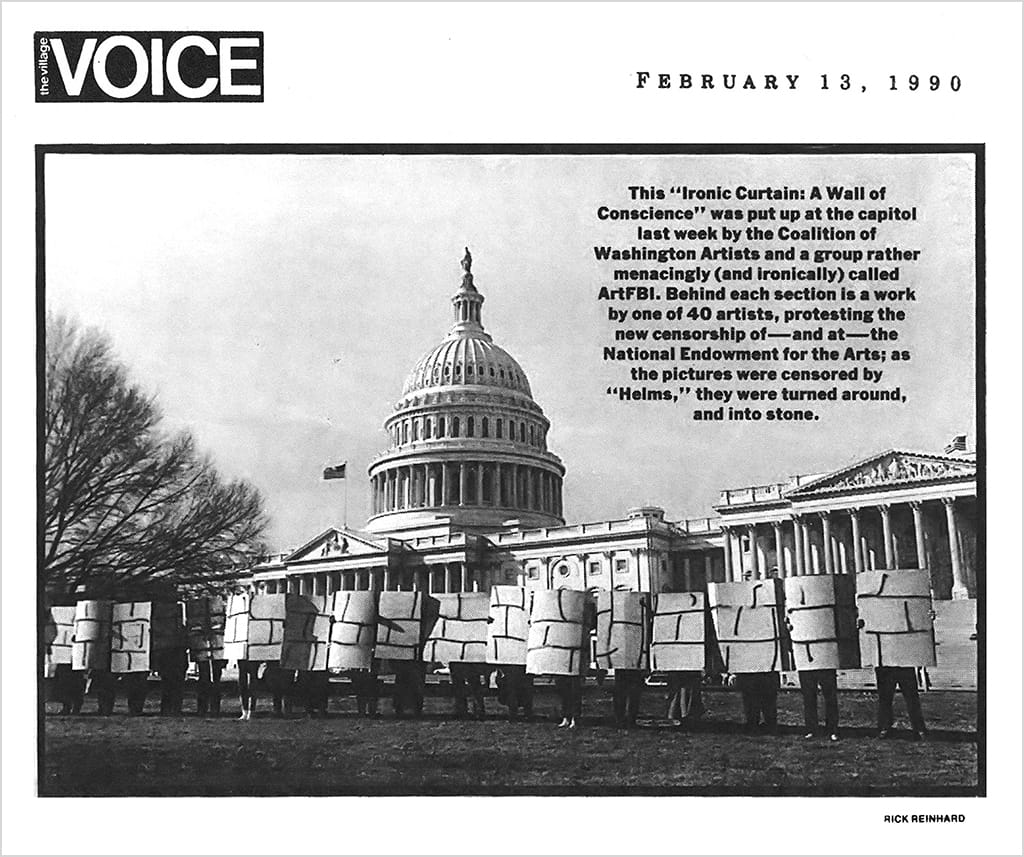
In February 1990, during attacks on artists by Congress, including Robert Mapplethorpe and Andres Serrano and the elimination of artists grants by the National Endowment for the Arts, ArtFBI, along with artists in the Washington, DC area, protested these actions in front of the National Capitol with The Ironic Curtain. A few months before, the Iron Curtain came down across Europe, symbolizing the end of the Cold War and the end of totalitarian efforts to curtail freedom of speech. ArtFBI found it ironic that just as freedom was being restored to Eastern Europe, these very rights were being threatened here in the United States.
Symposium: (Art)i(facts): Artists and Neighborhoods
On March 2 and 3, 1990, ArtFBI organized a symposium on how artists could get more involved in their communities. Held at Maryland Art Place in Baltimore, performance artist and art activist Suzanne Lacy gave the keynote address.
Two panel discussions were held to discuss non-traditional art practices and how artists could get more involved in their communities. Panelists on the Saturday morning program Alternatives to Traditional Art Practice included Julie Ault from Group Material in New York City, Ardai Baharmast and Anne Watts from Opus B in Baltimore, Judy Byron, a Washington, DC artist, and Tim Rollins, founder of Tim Rollins + KOS from Bronx, New York. Jeff Gates, Director of ArtFBI, was the moderator.
The Saturday afternoon program Nuts and Bolts: What to Know/Who to Know built on those alternative art practice examples discussed in the morning session and offered specific ways local artists could build engagement within their neighborhoods. Panelists included Diane Davidson from Maryland Lawyers for the Arts, Kimberly Camp, Director of the Experimental Gallery at the Smithsonian Institution, Gary Kachadourian from the Baltimore Mayor’s Advisory Committee on Art and Culture, and Belva Scott, Art and Culture Liaison, Office of Congressman Kweisi Mfume. Michele Mouré, Visual Arts Program Director for the Maryland State Arts Council, was the moderator.
ArtFax
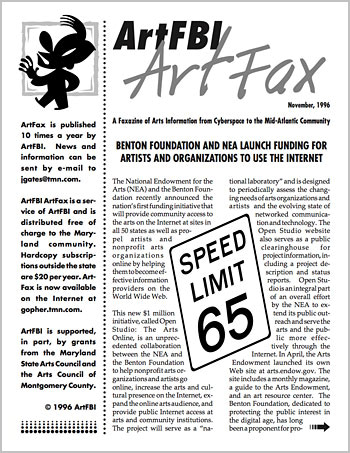
In the mid-1990s, the Internet was becoming a conduit for the quick dissemination of news and information. But access to the Net within arts communities was slow to develop. Like the rest of society, adoption was expensive (one needed a computer, an Internet connection, and a modem), and the benefits were unclear. But ArtFBI saw the importance of not only linking up with these developing news sources but also with other artists who were “connected.” Those years were the beginning of the online art community. ArtFax was a monthly “zine” of arts + advocacy information, published ten times a year, from 1995 to 1998. Download a sample copy. (PDF)
The initial reason for publishing this “faxazine” was to send important art information culled from the net to people who had no online access. Subscribers could get each issue faxed or mailed to them. Now the web is ubiquitous, and ArtFax is no longer needed.
Artist-related Bumper Stickers
Before the advent of social media, ArtFBI created a series of bumper stickers, “proto-social media if you will, to engage the public about who artists were. Here’s a personal story about such an interaction as I was driving on I-95:
“I was driving down the freeway at about 70 mph in my ’79 Honda (which had ArtFBI’s bumper sticker: ASK ME ABOUT BEING AN ARTIST) when an 18-wheeler pulled up beside me and motioned for me to roll down my window. I thought: Is there something wrong with my car?! Great! And I just put $500 into it. When I rolled down the window, the trucker yelled: ‘My son, he draws really well. What should he do?’
I thought, do I get into a philosophical discussion about what it’s like to be an artist at this speed?’ I decided if I wanted to continue being an artist, I’d better not. So I yelled back: ‘Call the Maryland Institute (where I taught art).’ He gave me the thumbs-up and drove on.”
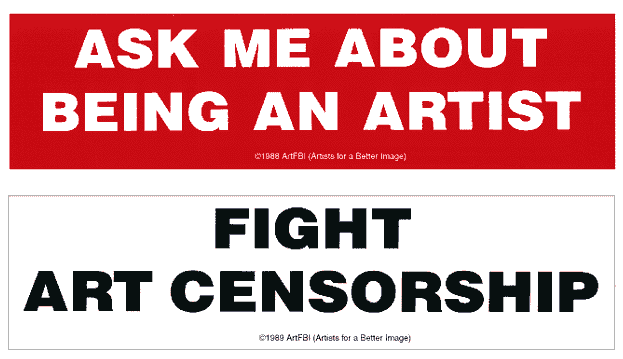
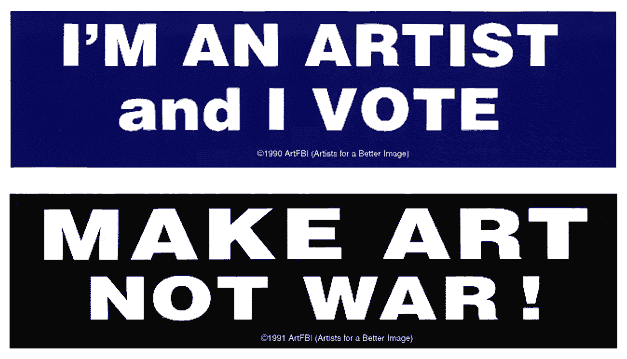
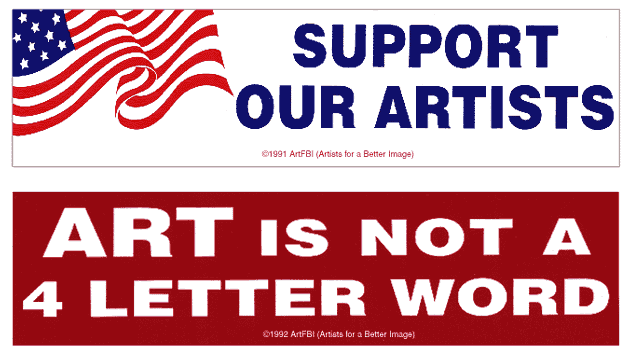
![Two ArtFBI Bumper Stickers: Self-Censorship Is Unartistic and Fear No Artists [done as rebus]](https://ml4b7znloqwu.i.optimole.com/cb:2BXn.2556d/w:626/h:356/q:mauto/f:best/https://i0.wp.com/outtacontext.com/wp-content/uploads/2021/06/bumpersticker4.gif?resize=626%2C356&ssl=1)
Bumper stickers are still available. Each one costs $3 plus a stamped and addressed business-size envelope. Volume discount rates are available for 25 or more in any combination. For further information contact me.
TV Bloopers and Practical Jokes: Media Representation of Artists
The main impetus for founding ArtFBI was to study and counter stereotypes of artists that have been prevalent in society since the beginning of the Industrial Revolution. With the culture wars in the early 1990s, where artists and their work were stigmatized and used to defund artist grants on both the national and local levels, ArtFBI’s purpose was to create dialogue with artists and the general public about who artists really were. Using depictions of artists from television and film, I traveled throughout the country to discuss stereotypes of artists, our roles in society, and why we presently find ourselves in the positions we do in our culture. More importantly, I wanted to discuss the attributes artists possess and how they could benefit society as we moved into the digital age.
As a starting point, in 1996, I authored New Roles for Artists in the Information Age. for the New York Foundation for the Arts. The article used Alvin Toffler’s three epoch periods of human society as defined in his book The Third Wave to discuss the roles artists played during those periods. First central to culture during the Agricultural Age, the Industrial Revolution, and the burgeoning market system separated artists from their work and communities. This was the beginning of the artist as an outcast and Bohemian. But the new digital age required a different set of skills, ones that artists were well-versed in. The need for these skills provided an opportunity for artists once again to become central to the success of businesses in this new Information Age.
That same year, I used this research as the basis for my keynote address at the National Council of Arts Administrators Annual Conference in Anchorage, Alaska.
• • •
ArtFBI is a non-profit organization studying stereotypes of artists in the media. For those who may have lost their sense of irony and humor in these difficult times, ArtFBI is not affiliated with the Federal Bureau of Investigation or any other government agency.



